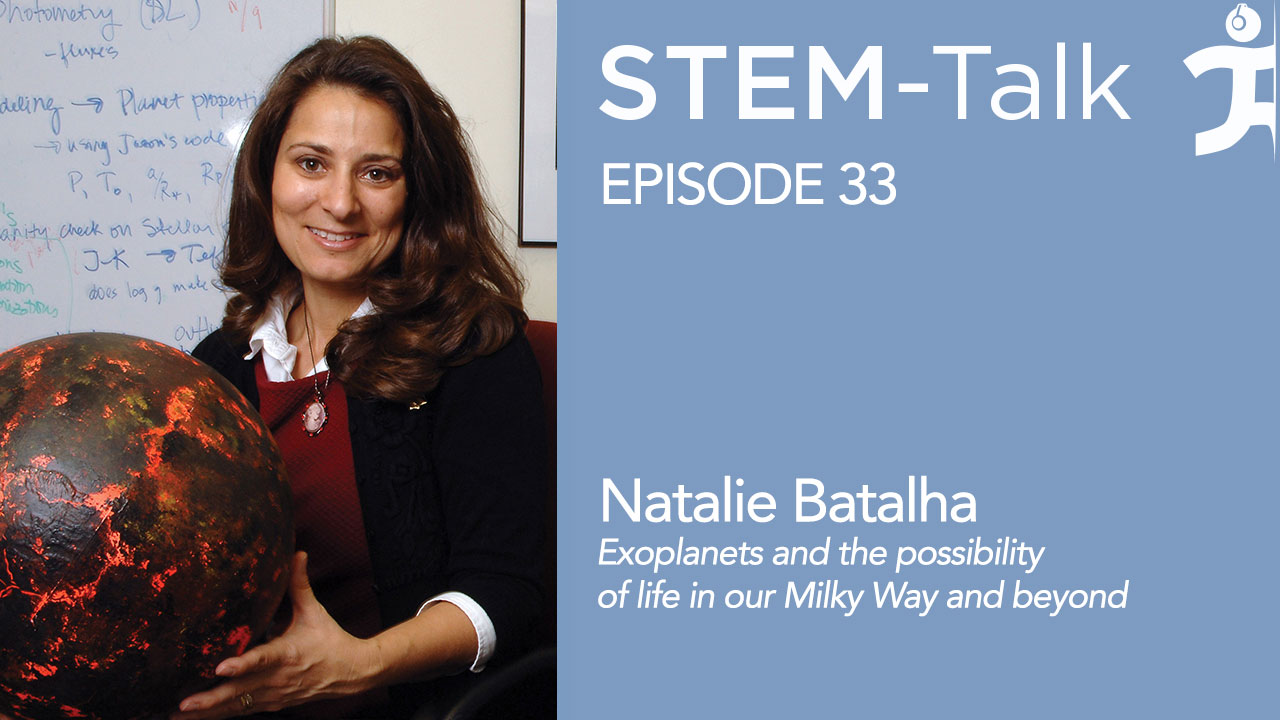STEM-Talk
Episode 33: Dr. Natalie Batalha talks about exoplanets and the possibility of life in our Milky Way and beyond
// Mar 14, 2017

Dr. Natalie Batalha’s STEM-Talk interview was so contagious that Dawn Kernagis said it made her dream of returning to school to get a second graduate degree in astronomy.
“Hearing Natalie talk about her research had all of us in the STEM-Talk studio buzzing,” said Dawn, the podcast’s co-host.
Natalie is an astrophysicist and the project scientist for NASA’s Kepler Mission, a space observatory launched by NASA to discover Earth-sized planets orbiting other stars. She sat down with Dawn and veteran astronaut and IHMC senior research scientist Tom Jones for episode 33 of STEM-Talk.
As one of the original co-investigators of the Kepler Mission, Natalie has been a leader in using the telescope to discover exoplanets, which are planets that orbit stars other than our own sun. Natalie has been involved in the Kepler Mission since the proposal stage and has helped identify more than 150,000 stars that are monitored by the telescope.
She holds a bachelor’s degree in physics from The University of California Berkeley, and a doctoral degree in astrophysics from UC Santa Cruz. She taught physics and astronomy for 10 years at San Jose State University before joining the Space Sciences Division of the NASA Ames Research Center, which is located in California’s Silicon Valley.
In 2011, Natalie received a NASA Public Service Medal for her vision in communicating Kepler’s science to the public, and also for her outstanding leadership in coordinating the Kepler science team. That same year Natalie also headed up the analysis that led to the discovery of Kepler 10b, the first confirmed rocky planet outside our solar system.
She joined the leadership team of a new NASA initiative in 2015, which is dedicated to the search for evidence of life beyond our solar system. Called the Nexus for Exoplanet System Science, the program brings together teams from multiple disciplines to understand the diversity of worlds, and which of those exoplanets are most likely to harbor life.
As if Dawn and the STEM-Talk gang weren’t excited enough after talking to Natalie about the search for life beyond our solar system, NASA announced about a month after our interview with Natalie that its Spitzer Space Telescope had revealed the first known system of seven Earth-sized planets around a single star. Three of these planets are firmly located in the habitable zone, the area around the parent star where a rocky planet is most likely to have liquid water.
According to a NASA press release in February, the discovery sets a new record for greatest number of habitable-zone planets found around a single star outside our solar system. All of these seven planets could have liquid water – key to life as we know it – under the right atmospheric conditions, but the chances are highest with the three in the habitable zone.
0:30: Dawn welcomes Ken Ford, IHMC founder and director as well as the chairman of the Double Secret Selection Committee that chooses guests who appear on STEM-Talk. Dawn and Ken then talk about Natalie’s background as an astrophysicist.
4:35: Dawn welcomes her co-host for this episode of STEM-Talk, Tom Jones, and they begin the interview by asking Natalie how she became interested in astronomy.
8:03: Natalie talks about how as an undergrad at Berkeley she met a post-doctoral researcher from Brazil who later became her husband. As a result, she ended up doing her post-doctoral work in Rio de Janeiro.
15:47: Dawn asks Natalie to describe the history of the Kepler mission.
19:00: Tom asks Natalie to describe the difficulty of trying to detect a distant planet.
21:34: Natalie describes how long the Kepler telescope has been in space and provides a summary of its findings.
25:30: Natalie talks about lava worlds, which have oceans larger than the Pacific Ocean, but they’re made of lava, which is why scientists call them lava worlds.
27:30: Dawn asks Natalie about the discovery of Kepler 10b, which was the identification of the first rocky planet outside of our own solar system.
32:30: Natalie describes how the host star that Kepler 10b orbits is almost exactly like Earth’s sun, except that it’s about 8 billion to 11 billion years old as opposed to our sun which is four and a half billion years old.
36:30: Dawn reads a quote that describes the discovery of Kepler 10lb as one of the most profound scientific discoveries in human history and asks Natalie to talk about that.
39:00: Tom asks Natalie to provide statistics on the kinds of planets that the Kepler mission is finding.
42:30: Natalie talks about planets in the Goldilocks Zone.
44:35: Break that features Ken talking about STEM-Talk, an educational service of the Florida Institute for Human and Machine Cognition, a not-for-profit research lab pioneering groundbreaking technologies, in that leveraging and extending human cognition, perception, locomotion, and resilience.
45:00: Tom comments that Kepler must have detected anomalies over the years, and asks if they occur frequently and what might cause these anomalies.
47:30: Natalie describes one of the most extreme examples of an anomaly, which is a star known as Tabby’s Star, or Boyajian’s Star.
51:30: Natalie talks about micro-lensing, which is a technique used to detect exoplanets.
53:00: Natalie gives an overview of the W First Mission, which is expected to launch in mid-2020s.
59:00: Dawn asks how many scientists are involved in analyzing Kepler’s findings and how the findings are confirmed.
1:00:30: Dawn asks how long the Kepler Mission will continue.
1:04:30: Natalie talks about plans to follow up on the Kepler Mission once its operations shut down.
1:07:00: Natalie talks about the Transiting Exoplanet Survey Satellite, which is a transit photometry mission that’s complementary to Kepler.
1:10:30: Tom asks Natalie to talk about the likelihood of habitable planets throughout the Milky Way.
1:12:30: Natalie says there are 10 to 20 billion potentially habitable Earth-sized planets in the galaxy.
1:16:00 Dawn asks Natalie for her thoughts about the need for society to prioritize learning about possible other planets that can support life.
1:20:00: Natalie talks about how the process of exploration and the act of pursuing knowledge changes us as a species and directly influences our quality of life on Earth.
1;23:30: Dawn asks Natalie about Pascal Lee and the SETI Institute, also known as the Search for Extraterrestrial Intelligence Institute.
1:24:02: Tom mentions that he’s fascinated by the idea of rogue planets and asks Natalie if they’re real.
1:27:00: Dawn mentions that Ken often comments how astronomers have the coolest scientific jargon, which includes terms like red dwarf stars, gravity waves, gas giants and galactic cannibalism.
1:27:30: When Dawn asks Natalie what she does for fun outside of searching for planets, Natalie talks about growing grapes and making wine with her father.
1:30:00: Natalie ends the interview by encouraging young people to do what they love and to find what gives meaning to their life.
1:33:00: Dawn and Ken sign off.






